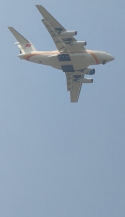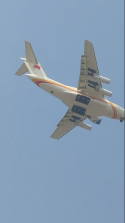not really, they did it because most of the 2 engine aircrafts were more efficient when they came out. Don't try to argue with me on this, since I actually talk to people in the industry.Industry went from 4 engine to 2 engine for maintenance optimization reasons though.
You are using an out of date browser. It may not display this or other websites correctly.
You should upgrade or use an alternative browser.
You should upgrade or use an alternative browser.
Chinese Engine Development
- Thread starter jackbh
- Start date
I'm aware that when the 777 and A330 came out the sell for going two engines was that engine providers had new high thrust variants that were more efficient so 4 engines were unnecessary. There was even a strong push by engine providers on selling the reliability of these new engines to cover failure redundancy concerns as well. However, maintenance cost reduction was also a selling point. It wasn't just one reason.not really, they did it because most of the 2 engine aircrafts were more efficient when they came out. Don't try to argue with me on this, since I actually talk to people in the industry.
"Another cost consideration for airlines is maintenance. This may not seem as obvious as fuel costs, but almost half of typical maintenance costs is engine related ( have published a detailed guide to maintenance costs here) – so costs rise quickly with four engines."
"Analysts say advances in engine technology and fuel-efficiency have made twin-engine jets the go-to choice when airlines look to update their passenger fleets.
Patrick Smith, host of the , says economics swung the pendulum — perhaps irreversibly — toward two-engine passenger planes. "
“It's pretty simple: Why do with four what you can do with two? It's going to be simpler and less expensive,” Smith says.
…
Jets with four engines — and some with three — remained a staple of passenger flying, especially on long-haul intercontinental flights.
By the 1990s, volatile fuel prices, improved reliability and reduced operating costs all began to tip the scales in favor of jets with fewer engines. “
Last edited:
Also ETOPS came into play in the 1980s with longer time allowed between airport for twin jets. Before the 1980s a minimum of 3 turbine engines were required to be more than 60 minutes of flight to any airports. Before 1964 it was 4 engines required... So long flight over sea was for more than twin jets... When extended ETOPS came into play, twins started to rule the day.I'm aware that when the 777 and A330 came out the sell for going two engines was that engine providers had new high thrust variants that were more efficient so 4 engines were unnecessary. There was even a strong push by engine providers on selling the reliability of these new engines to cover failure redundancy concerns as well. However, maintenance cost reduction was also a selling point. It wasn't just one reason.
"Another cost consideration for airlines is maintenance. This may not seem as obvious as fuel costs, but almost half of typical maintenance costs is engine related ( have published a detailed guide to maintenance costs here) – so costs rise quickly with four engines."
"Analysts say advances in engine technology and fuel-efficiency have made twin-engine jets the go-to choice when airlines look to update their passenger fleets.
Patrick Smith, host of the , says economics swung the pendulum — perhaps irreversibly — toward two-engine passenger planes. "
“It's pretty simple: Why do with four what you can do with two? It's going to be simpler and less expensive,” Smith says.
…
Jets with four engines — and some with three — remained a staple of passenger flying, especially on long-haul intercontinental flights.
By the 1990s, volatile fuel prices, improved reliability and reduced operating costs all began to tip the scales in favor of jets with fewer engines. “
Doesn’t look like a PS but someone should post the original video to be sure. The engine looks like it’s got an AECC livery potentially. If that’s what it is it confirms the CJ-1000 flying on a Y-20.Anyone get any idea what the engine is? Comment section claims it is a CJ-1000A tested on Y-20 because it is in COMAC paint. Or photoshopped as usual?
View attachment 109714
Last edited:
Can post the link? Is it posted on Weibo?Can confirm it is not PSed, just the original video but dunno how to post it.
Screenshot:
View attachment 109715View attachment 109716
Can post the link? Is it posted on Weibo?
whxl子涵 from Kuaizhou app has the original video.
It is complete and utterly legit. In fact testing has started as early as January as per the following report:

It is almost as if Chinese turbofan development, after 30 years of slow methodical boning, has finally climaxed and is now blowing its load every where.
Last edited:
I don't see why this couple of guys would know what they are talking about. Do you think pilots would know operational economics better than people who actual operate a fleet?I'm aware that when the 777 and A330 came out the sell for going two engines was that engine providers had new high thrust variants that were more efficient so 4 engines were unnecessary. There was even a strong push by engine providers on selling the reliability of these new engines to cover failure redundancy concerns as well. However, maintenance cost reduction was also a selling point. It wasn't just one reason.
"Another cost consideration for airlines is maintenance. This may not seem as obvious as fuel costs, but almost half of typical maintenance costs is engine related ( have published a detailed guide to maintenance costs here) – so costs rise quickly with four engines."
"Analysts say advances in engine technology and fuel-efficiency have made twin-engine jets the go-to choice when airlines look to update their passenger fleets.
Patrick Smith, host of the , says economics swung the pendulum — perhaps irreversibly — toward two-engine passenger planes. "
“It's pretty simple: Why do with four what you can do with two? It's going to be simpler and less expensive,” Smith says.
…
Jets with four engines — and some with three — remained a staple of passenger flying, especially on long-haul intercontinental flights.
By the 1990s, volatile fuel prices, improved reliability and reduced operating costs all began to tip the scales in favor of jets with fewer engines. “
It's a commonly held belief by many around the industry that 2 engines is better than 4. As I said, Leeham news, which imo is the most professional of all aerospace sources, did a real study into it and found that the operating cost (and for airlines, that would include all aspect of engine cost) for 2 vs 4 engine aircraft is about the same. It actually makes no sense why Leap-1A would be harder to maintain than GE9X. Now, in the case of A380, there weren't many of them around, so there weren't many A380 engines compared to 77W engines. Sure, when there are fewer engines around to maintain and fewer fleets operate them, then it's costs go up.
Notice, I didn't mention GTF here. That's a new technology that Pratt spent 30 years and still couldn't get right until many years after service entrance.
the new engine test bed based on Y-20Anyone get any idea what the engine is? Comment section claims it is a CJ-1000A tested on Y-20 because it is in COMAC paint. Or photoshopped as usual?
View attachment 109714



